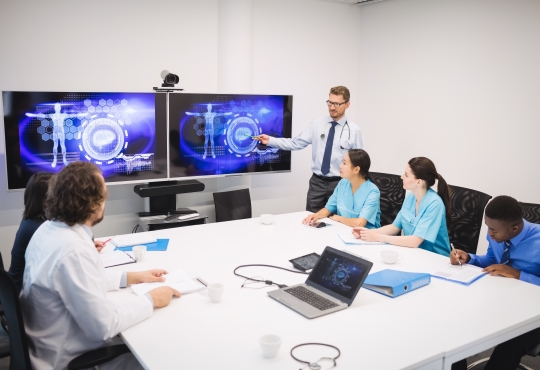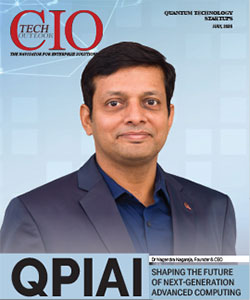Edge Computing in Healthcare: Revolutionizing Patient Care
Fiona Catherine Jerry | Wednesday, 06 September 2023, 13:48 IST
 Edge computing, a rapidly advancing frontier, is set to fundamentally alter healthcare on a global scale. According to industry forecasts, the global Edge Computing market in Healthcare is expected to skyrocket, reaching a staggering $25.5 billion by the year 2030, with an impressive compound annual growth rate (CAGR) of 26.9% during the forecast period. This exponential growth can be attributed to the numerous advantages that edge computing brings to healthcare. It enables real-time data analysis and decision-making, improving patient outcomes and reducing delays in treatment. On top of that, edge computing enhances data security and privacy by reducing the need for data to be transmitted to centralized servers, ensuring sensitive patient information remains secure and protected. Overall, its adoption in healthcare is transforming the industry by enhancing efficiency, security, and accessibility.
Edge computing, a rapidly advancing frontier, is set to fundamentally alter healthcare on a global scale. According to industry forecasts, the global Edge Computing market in Healthcare is expected to skyrocket, reaching a staggering $25.5 billion by the year 2030, with an impressive compound annual growth rate (CAGR) of 26.9% during the forecast period. This exponential growth can be attributed to the numerous advantages that edge computing brings to healthcare. It enables real-time data analysis and decision-making, improving patient outcomes and reducing delays in treatment. On top of that, edge computing enhances data security and privacy by reducing the need for data to be transmitted to centralized servers, ensuring sensitive patient information remains secure and protected. Overall, its adoption in healthcare is transforming the industry by enhancing efficiency, security, and accessibility.
Real-Time Patient Monitoring:
Real-time patient monitoring is a crucial aspect of healthcare that allows healthcare providers to continuously monitor the vital signs and conditions of their patients. This technology enables healthcare professionals to detect any abnormalities or changes in a patient's health status immediately, allowing for early intervention and improved patient outcomes. Real-time patient monitoring systems typically involve the use of wearable devices, such as heart rate monitors or blood pressure cuffs that transmit data wirelessly to a central monitoring station or healthcare provider's smartphone or tablet. Overall, real-time patient monitoring plays a vital role in ensuring the timely and effective delivery of healthcare services.
Enhanced Diagnostic Capabilities:
Edge computing enhances diagnostic capabilities by allowing for faster and more accurate medical imaging and data analysis. With the ability to process large amounts of data locally, wearable devices can provide real-time insights and alerts to healthcare providers, leading to more timely and precise diagnoses. This not only improves patient outcomes but also reduces the need for invasive procedures and unnecessary tests, resulting in cost savings for both patients and healthcare systems. Additionally, edge computing enables the integration of artificial intelligence algorithms, which can further enhance diagnostic accuracy by analyzing complex patterns and predicting potential health issues.
Remote Patient Care and Telemedicine:
Edge computing enables real-time data processing and analysis at the edge of the network, allowing healthcare professionals to access and interpret patient data instantly. This helps in diagnosing conditions more accurately and expeditiously. Additionally, edge computing supports remote patient monitoring, telemedicine, and virtual healthcare, enabling patients to receive medical attention from the comfort of their homes, especially in rural or underserved areas. This not only increases accessibility to medical services but also reduces the burden on healthcare facilities and improves patient outcomes.
Data Security and Privacy:
Data security and privacy are of utmost importance in the healthcare industry, especially when it comes to handling sensitive patient data. Edge computing solutions utilize robust encryption protocols and stringent access controls to safeguard patient information. These solutions also adhere to strict healthcare regulations, such as HIPAA, ensuring that data is handled securely and confidentially. By providing a secure environment for data storage and transmission, edge computing instills trust in patients, ultimately encouraging them to embrace virtual healthcare options. The decentralized nature of edge computing reduces the risk of data breaches and unauthorized access, giving patients peace of mind. Furthermore, the secure and confidential handling of sensitive information builds a foundation of trust between patients and healthcare providers, fostering a positive and reliable virtual healthcare experience. Healthcare and life science organizations are increasingly the subject of malware/ransomware attacks.
Jeff Dymond, the CTO for Manufacturing at Dell Technologies, and Steve Lazer, the Global CTO for Healthcare & Life Sciences at Dell Technologies, were quoted in an article on Healthcare IT Today. - “Data privacy and security need to be a primary focus when generating and storing edge data, not an afterthought. Utilizing root of trust, secure supply chains and zero trust processing can enhance these capabilities in the healthcare technology infrastructure.”
Predictive Analytics and Personalized Treatment:
Edge computing supports predictive analytics and personalized treatment plans by allowing healthcare providers to collect and analyze real-time data at the edge of the network. This enables healthcare professionals to make quicker and more accurate predictions about a patient's health condition, leading to more effective and timely interventions. Additionally, edge computing facilitates the customization of treatment plans based on individual patient data, ensuring that healthcare interventions are tailored to meet the specific needs and preferences of each patient.
We are on the cusp of a healthcare revolution, and the integration of edge computing is at the heart of it all. Real-time patient monitoring, improved diagnostics, accessible remote care, stringent data security, and personalized treatments are the cornerstones of this transformation. With edge computing as our ally, healthcare is becoming more proactive, precise, and patient-focused. The possibilities are limitless, and the potential to enhance healthcare outcomes and experiences is brighter than ever. By harnessing the power of edge computing, we're not just changing patient care; we're ensuring a healthier, more connected, and secure future for all.




